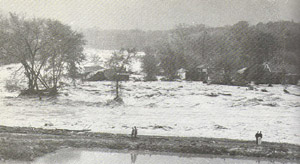
This is an appropriate day to take stock in the quality of emergency preparedness measures we often take for granted. It is appropriate because on Saturday, October 16, 1954 - fifty years ago to the day, a sleepy Toronto wakened to the sight of a disaster on a magnitude that could never have been imagined. It was the morning after the remnants of
Hurricane Hazel whipped through the city killing 81, and leaving hundreds of millions (in today's dollars) of damage.
From my standpoint, this is not as much about why Toronto suffered so such destruction, as it is about how far we have come since that fateful day. To begin with, Toronto was susceptible to the effects of Hazel because of its geography and population. The city is centered at a point where four large rivers empty into Lake Ontario, and on that night, the death and destruction wasn't caused by excessive wind speed, but as a result of massive flash floods that swept through residential areas that had been built on floodplanes (there was, in fact an entire street -
Raymore Drive - that was swept away when the banks of the Humber river overflowed).
Even before realizing this was Hazel's 50th anniversary, I was playing golf earlier in the week at the Don Valley Golf Course, and turned a mediocre round into a good one as soon as I hit the 12th hole - a long straight par 5 that runs parallel to the nearby Don River. As I was walking down the fairway of the course where I learned to play the game as a kid, I was reminded of something that happened a long time ago when I happened upon a manhole cover in the middle of the fairway that inexplicably reads '1927.' As a local, I remembered the significance immediately - it used to sit right in the middle of a street that was washed away by the storm. This gave me the itch to re-read a book I had read more than 20 years ago simply titled "Hurricane Hazel" by former Toronto broadcaster
Betty Kennedy. In it she describes a city that was utterly unprepared for any kind of disaster, let alone a catastrophic flood.
There were three primary reasons for the death and destruction:
1. Vague Meterological Information and Limited Media Reach - The following was the official forecast issued by the weather office in Toronto at 9:30 p.m. on Friday October 15 (about two hours before the storm struck):
Rain tonight. Cloudy with occasional showers Saturday. Little change in temperature. Winds north 40 to 50 this evening decreasing overnight to northwest 30 Saturday.
2. No definable building code prohibiting construction on floodplains - at the time residential areas built on the shores of rivers were common, today, all of these areas have been transformed into
parkland.
3. No organized civil defense department or structured emergency services - here are two exerpts from Kennedy's book that really drive the point home:
"Toronto was without a civil-defence unit. There were about forty auxiliary policemen who had signed on for a new training plan, but were not called upon as a group because they had absolutely no equipment"
East of Toronto, the Rouge River was in full spate, very different from the placid stretch of water Ted Ryan thought he knew: "Shortly after 10:00 that night the phone rang. It was my friend and neighbour, Fred Hunt. He asked me if he could borrow my auto-top boat which we used for duck hunting as he had gotten word at the corner store ther were one or two families stranded in the lower Rouge River due to flooding...I asked him to wait for me there until I got more appropriately dressed...there was no way I was going to miss out on this adventure as the Rouge areas was quite rural at this time and this sort of thing was one of out pleasures...Of course, I had in mind that we would serenely cruise down the river and, with some luck, possibly rescue a damsel in distress"
Next time we find ourselves thinking about how the need to shore up the emergency preparedness infrastructure, think about how much better prepared we are today compared with 50 years ago. We've come a long way from the days when our primary motivation in disaster management was rescuing damsels in distress.

